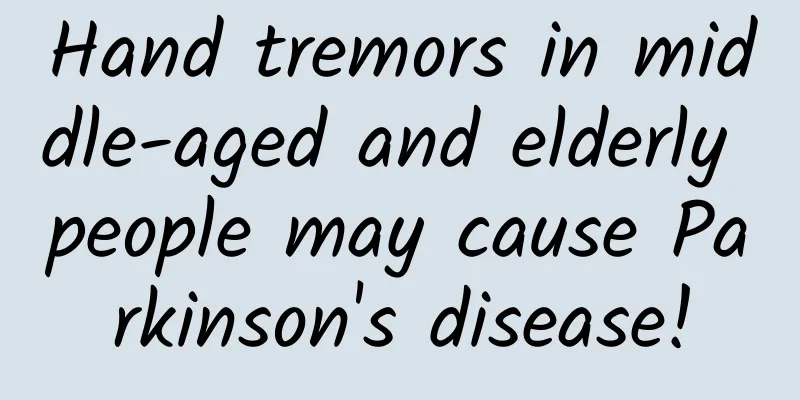Hand tremors in middle-aged and elderly people may cause Parkinson's disease!

|
Friends who have middle-aged or elderly people at home always habitually pay attention to the various physical conditions of the elderly, such as whether they have coughs and sputum, headaches and fever, etc. Once these conditions occur, family members will be nervous, fearing that the elderly will have major health problems. Although what we are going to talk about today is not a common problem like headache and fever, it is also a common disease among middle-aged and elderly people, it is called Parkinson's disease. Compared with Alzheimer's disease, many people may be relatively unfamiliar with Parkinson's disease, which also causes many patients to fail to receive regular treatment in time and cause the disease to worsen. This article mainly provides a brief introduction to this disease, and I hope it can be helpful to everyone. Parkinson's disease, also known as tremor paralysis, is a common neurological systemic degenerative disease in middle-aged and elderly people. The average age of onset is about 55 years old, and it is more common after the age of 60. It is relatively rare before the age of 40 [1]. The overall prevalence rate of people over 65 years old in my country is 170/100,000 [2]. In addition, this disease has a gender characteristic, with men slightly more likely to have it than women. The main pathological change of Parkinson's disease is the degeneration and death of dopaminergic neurons in the substantia nigra of the midbrain, which causes a significant decrease in the dopamine content in the striatum and causes the disease. Parkinson's disease is related to genetic factors, environmental factors, and aging, but scientists are still unclear about the specific cause of the disease. There are two main clinical manifestations of Parkinson's disease: motor symptoms and non-motor symptoms. The core motor symptoms of Parkinson's disease are tremor, bradykinesia and rigidity. Although "postural instability" is often mentioned, this symptom usually appears in the late stage of the disease and is not included in the diagnostic criteria for Parkinson's disease. Resting tremor is often the first symptom of Parkinson's disease. It usually starts at the distal end of one upper limb. It appears or becomes obvious when the patient is in a static position, decreases or stops during voluntary movement, increases when the patient is nervous or excited, and disappears after falling asleep. The typical manifestation is a "pill-rolling" movement between the thumb and the flexed index finger. Bradykinesia is slow movement and a decrease in the amplitude or speed of sustained movement. It can occur in many parts of the body, such as the voice, face, limbs, etc. It manifests as a decrease in voluntary movement, slow and clumsy movements. Myotonia is the passive slowness of the major joints of the limbs and neck when the patient is in a relaxed position. Postural balance disorder is a kind of balance and tendency to fall caused by central nervous system-mediated posture damage. As the disease progresses, the patient may have a gradual decrease in steps and slowness, with gait disorders being particularly obvious when starting and turning, and difficulty in standing up from a sitting or lying position. In addition to motor symptoms, non-motor symptoms are also common and important clinical manifestations of Parkinson's disease, which can occur before or after the onset of motor symptoms. The main manifestations are sensory disorders, mental disorders, autonomic dysfunction and sleep disorders. The most common sensory disorders include decreased sense of smell, pain or numbness; the most common mental disorders include depression and/or anxiety, hallucinations, cognitive impairment or dementia; autonomic dysfunction mainly includes orthostatic hypotension, constipation, dysphagia, sweating, etc.; sleep disorders affect 55%-80% of patients, mainly including insomnia, excessive daytime sleepiness, etc. Although there are currently medications and surgical treatments for this disease, these two treatments can only improve the patient's symptoms, but cannot prevent the progression of the disease, let alone cure it. So friends must pay attention, any advertisements that claim to be able to cure Parkinson's disease are not credible. Here we also remind friends who have middle-aged or elderly people at home to pay more attention to whether the elderly have the above symptoms. If you suspect they have any, please go to a regular hospital to see a doctor for early diagnosis and treatment. References: [1]. Jia Jianping, Chen Shengdi, et al., Neurology, 7th edition, People's Medical Publishing House, 2013, P278. [2]. Du Xiaoli, Wang Qiumei, et al., Comprehensive Knowledge and Skills of Pharmacy, 8th edition, China Medical Science and Technology Press, 2021, P291. |
<<: Can moyamoya disease cause repeated cerebral hemorrhage?
Recommend
These diseases are prone to overlapping infections, and some people have already been infected! Disease control in many places have spoken out one after another
The weather is getting colder, but autumn is stil...
After sex, I feel a spicy sensation down there
Sexual intercourse is a very pleasurable thing fo...
Why is Brazilian agate so cheap (the output is very large and there is no shortage in the market)
...
Can I have a natural birth if I have hepatitis B?
Everyone knows that hepatitis B is contagious and...
Where is the female thyroid gland located?
The thyroid gland regulates these responses by pr...
Are compressed biscuits delicious? How are compressed biscuits made?
Are compressed biscuits delicious? People who hav...
What causes hard nipples during breastfeeding?
Breastfeeding mothers need to secrete milk to fee...
Can I drink safflower during menstruation?
Can you drink safflower during menstruation? When...
36 weeks pregnant vaginal pain
After pregnancy, you will experience various disc...
Can I use salt water to wash my labia during pregnancy?
The private parts of pregnant women are very vuln...
Why do I feel particularly hungry during breastfeeding?
During the breastfeeding period, the most importa...
Can women take Panax notoginseng powder during menstruation?
Panax notoginseng is a traditional Chinese medici...
When is Cold Dew in 2021? Is it better to have rain or not?
Cold Dew is one of the 24 traditional solar terms...
I was pregnant the same month I took my chest X-ray.
Everyone knows that X-rays contain radiation, so ...
Can I eat pears during menstruation?
We all know that the pear is a fruit with a relat...









